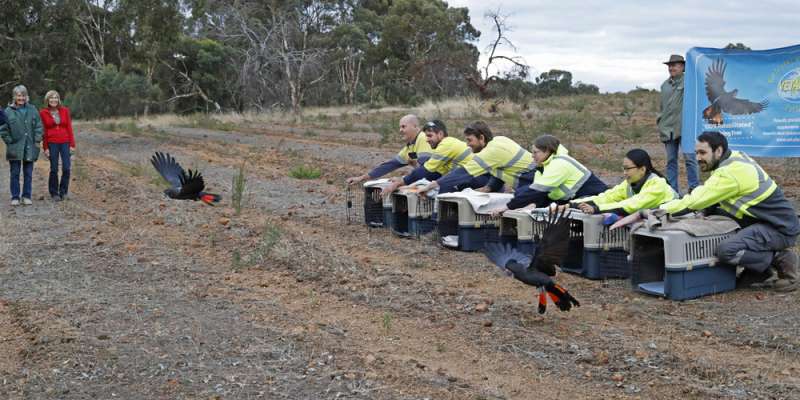500th rehabilitated black cockatoo released into wild

An endangered black cockatoo has become the 500th rehabilitated cockatoo to be released into the wild as part of a collaborative research project involving Murdoch University.
The forest red-tailed black cockatoo was treated by Perth Zoo vets and recovered at Kaarakin Black Cockatoo Conservation Centre.
It was released at a farm site near Boddington with five other cockatoos fitted with satellite and/or GPS tags.
They flew off to join the large resident flock of black cockatoos at Hotham Farm, a 450ha restoration area around 120 km south east of Perth. Hotham Farm is owned by project co-funder, Newmont Boddington Gold.
Murdoch researchers will be tracking the iconic birds, which are endemic to South-West Australia, to assist with management and recovery plans.
The release of the tagged birds is the second in the Boddington area, and will help the researchers understand more about their habitat use.
In February 2017, 10 rehabilitated forest red-tailed black cockatoos were released in the Boddington area. Four birds carried satellite transmitters, with three carrying an additional GPS package.
The tagging program will help researchers understand the foraging, breeding and roosting patterns of the iconic birds.
Project lead Associate Professor Kris Warren, from the School of Veterinary and Life Sciences, said the information generated by tagged birds was urgently needed.
"Populations of black cockatoos and other fauna are in decline across Western Australia because of the loss of native vegetation to land clearing for agricultural, urban and industrial development reducing the amount of food and shelter available," Professor Warren said.
"Climate change, competition with other species like bees for nesting hollows, and human impacts like vehicle strikes, illegal shooting and poaching, are also driving the declines.
"So we need to understand key aspects of their ecology to inform assessments of proposed land uses and enable proponents to deliver best-practice land use for black cockatoo conservation."
Ph.D. student Karen Riley has spent the last year monitoring and obtaining data for the cockatoos released in 2017, and said the birds had integrated well into the resident flocks.
She was also able to identify new roost sites, a foraging habitat and a suspected breeding site.
Tracking devices have been fitted to wild black cockatoos for the past four years. They were treated for injury at Perth Zoo and rehabilitated for release back into the wild at Kaarakin Black Cockatoo Conservation Centre.
The tail-mounted satellite tags gather data eight times a day, with the back mounted GPS transmitter providing valuable data every 2.5 minutes. This precise tracking allows the research team to follow the birds in great detail during the project.
Provided by Murdoch University




















